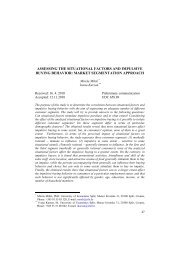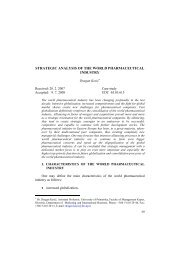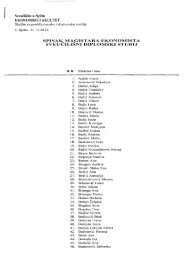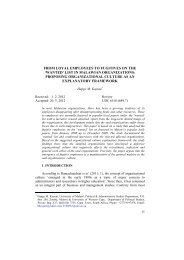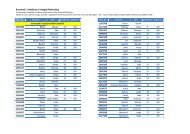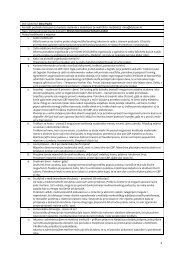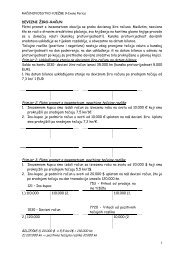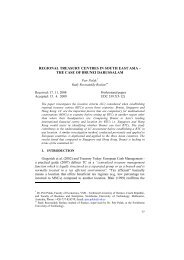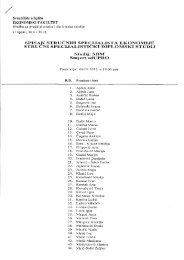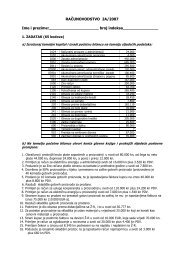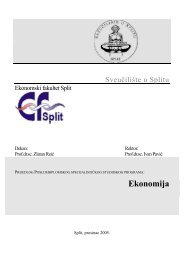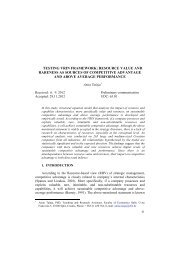Case study: Downsizing strategy influence on the structure of the firm
Case study: Downsizing strategy influence on the structure of the firm
Case study: Downsizing strategy influence on the structure of the firm
Create successful ePaper yourself
Turn your PDF publications into a flip-book with our unique Google optimized e-Paper software.
Management, Vol. 17, 2012, 1, pp. 75-92<br />
A. H. de E. E. de los M<strong>on</strong>teros, C. S. Bravo: <str<strong>on</strong>g>Case</str<strong>on</strong>g> <str<strong>on</strong>g>study</str<strong>on</strong>g>: <str<strong>on</strong>g>Downsizing</str<strong>on</strong>g> <str<strong>on</strong>g>strategy</str<strong>on</strong>g> <str<strong>on</strong>g>influence</str<strong>on</strong>g> <strong>on</strong> <strong>the</strong> …<br />
With this new scenario, Telefónica centred its development over <strong>the</strong> next<br />
three years, based <strong>on</strong> three sources <strong>of</strong> growth:<br />
• Fur<strong>the</strong>r strategic alliances in n<strong>on</strong>-core businesses<br />
• Latin America expansi<strong>on</strong><br />
• Business development and acquisiti<strong>on</strong> agreements. It is important to<br />
emphasize <strong>the</strong> media business, which tries to maximize <strong>the</strong> value <strong>of</strong><br />
Telefónica distributi<strong>on</strong> networks and streng<strong>the</strong>n <strong>the</strong> capacity <strong>of</strong> creati<strong>on</strong><br />
and exploitati<strong>on</strong> <strong>of</strong> c<strong>on</strong>tent. During 2000-2003, Telefónica Media was<br />
developed through agreements and acquisiti<strong>on</strong>s, as Endemol, Via<br />
Digital TV and Antena 3 in Spain or through Telefé and Canal Azul in<br />
Argentina.<br />
From 2003, Telefónica focused its management priorities <strong>on</strong> streng<strong>the</strong>ning<br />
its positi<strong>on</strong> in key markets and improving operati<strong>on</strong>al efficiency, c<strong>on</strong>tinuing<br />
with <strong>the</strong> cost c<strong>on</strong>trol policy and investment, by divesting in businesses that had<br />
not reached <strong>the</strong> projected development. Thus, <strong>the</strong> business <strong>of</strong> Telefónica Media,<br />
which developed greatly since 2000, suffers divestiture and reorganizati<strong>on</strong><br />
processes from <strong>the</strong> year 2003 because thanks to Telefónica’s size, Telefónica<br />
could negotiate, with advantage, <strong>the</strong> broadband c<strong>on</strong>tent without being tied to a<br />
specific producti<strong>on</strong> company. This downscoping <str<strong>on</strong>g>strategy</str<strong>on</strong>g> culminates when<br />
Endemol was sold in 2007. At <strong>the</strong> same time, Telefónica performed investment<br />
rearrangement processes <strong>of</strong> n<strong>on</strong>-strategic assets, such as Airwave, specialized in<br />
digital security communicati<strong>on</strong>s, or TPI, specialized in <strong>the</strong> teleph<strong>on</strong>e directory<br />
market.<br />
Parallel to this process <strong>of</strong> divestment, since 2005 Telefónica c<strong>on</strong>centrated<br />
its activities in <strong>the</strong> telecommunicati<strong>on</strong>s business, expanding <strong>the</strong>ir business in <strong>the</strong><br />
Value Added Services and digital c<strong>on</strong>tent. The key business grew<br />
geographically, emphasizing <strong>the</strong> acquisiti<strong>on</strong> <strong>of</strong> all shares <strong>of</strong> O2, <strong>the</strong> 50% <strong>of</strong><br />
Colombia Telecomunicaci<strong>on</strong>es SA, later renamed Telefónica Telecom, <strong>the</strong><br />
increased participati<strong>on</strong> in Telecom Italia and <strong>the</strong> entry and increased<br />
participati<strong>on</strong> in China Netcom Group. In additi<strong>on</strong> to <strong>the</strong> development al<strong>on</strong>g<br />
<strong>the</strong>se years, Telefónica changed its <strong>structure</strong> to fit <strong>the</strong> <str<strong>on</strong>g>strategy</str<strong>on</strong>g> defined by <strong>the</strong><br />
following phases:<br />
• In 1994, a <strong>structure</strong> focused in business lines, markets, customers and<br />
products was approved. The corporate centre in turn guided <strong>the</strong> group’s<br />
<str<strong>on</strong>g>strategy</str<strong>on</strong>g> and carried out planning, corporate finance and instituti<strong>on</strong>al<br />
relati<strong>on</strong>s. Finally, two units <strong>of</strong> shared resources and infra<strong>structure</strong><br />
provided support to business units.<br />
• In 1999, a new <strong>structure</strong> was created to take advantage <strong>of</strong> geographical<br />
business opportunities and new business lines due to <strong>the</strong> growing<br />
83



